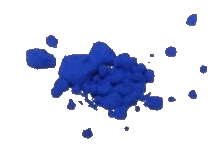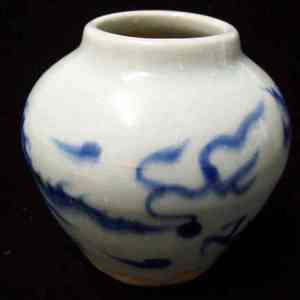Blue Pigments Used in Chinese Porcelain
Sumali and other blue pigments used in Chinese porcelain
According to Chinese sources the following blue pigments were in use in China:
In all there were seven (7) different types of such pigments in
use.
- 5 types were from domestic sources
- 2 types were imported
Local pigments:
- Mineral pigments sourced in: Jiangxi (2), Zhejiang (1), Yunnan (1)
- Chemical pigments: imported und used in the late Qing dynasty (19th century)
Imported pigments
The imported mineral pigments were assumedly sourced in the Middle East
(with the possibility for another option open). Existing records are
providing no reliable information about the actual sources.
There are conflicting explanations regarding the actual source
of Sumali blue (蘇料) and the Mohammedan blue (回青) cobalt based pigments that were both imported.
Ancient Chinese documents are not sufficiently reliable, and is suspected that two or more of the Chinese names used for these may have been recorded erroneously.
Generally said, the
imported pigments were of a bright blue color, whereas local pigments
were darker, sometimes more gray or blackish looking than blue. They were also mixed, resulting in different color tones.
 |
It is assumed that the imported pigments were probably too
expensive for the average kiln, and thus only some mainstream kilns or the
official (imperial) kiln could afford these. The other blue pigments
used were mined in various places in China. |
Note:
(Readings of the Chinese names given below are in Pinyin.)
Corrections added 10/23 2014 after obtaining new information: 1) Chinese document from 1970s, 2) research document dated 2008.
Sumali Blue (蘇麻離)
The cobalt-based blue pigments called "Sumali" apparently originated in the Middle East.
A report based on scientific/chemical analyses research done in 2008 seems to contradicts the explanation that "Sumali" blue was the name for Sumatran blue. It suggests that the name "Sumali" would have been rather a sinification of "Samarra" blue. Samarra was then a pottery center in the are of today's Irak. The mineral pigments are suspected to have been mined in other areas, however, candidates being elsewhere in Irak or Persia; Persia seems to be the favorite.
No definitive proof exists in Chinese records or annals, so we may never be sure. The pigment's name may stem from its association with merchants coming from the Samarra pottery area. They are thought to have brought the pigment to China when ordering blue and white porcelain.
Sunibo aka Mohammedan blue (回青)
Currently, suspected origin of Sunibo is Sumatra which was important during the time, and was a regional trading hub in those times. Historical records show that l
The other several names for imported pigments, like Sunima, Suboni,
Sunibo may all refer to the other imported pigment, which is suspected to
have been mined in Sumatra, detailed origin not known as yet.
However,
there are apparently Chinese historical records mention that this blue
pigment was part of tribute sent to the court in China by a Sumatran
kingdom, in the early Ming dynasty.
|
Right: Confusing terminology |
 |
.......................................................................................
During the Xuande reign(*) of the Ming dynasty the imported pigments became depleted and unavailable to kilns. They had to switch to locally mined pigments which have different blue tones.
Therefore, whether a porcelain item was fired with Sumali, Sunibo or other blue pigments can therefore be used for verifying if an item was possibly made at a certain time.
* An older Chinese research document from approx. 1970 mentions Xuande as the reign when Sumali pigment was depleted. However several other sources indicate that some Sumali was still in use during the early Chenghua reign.
